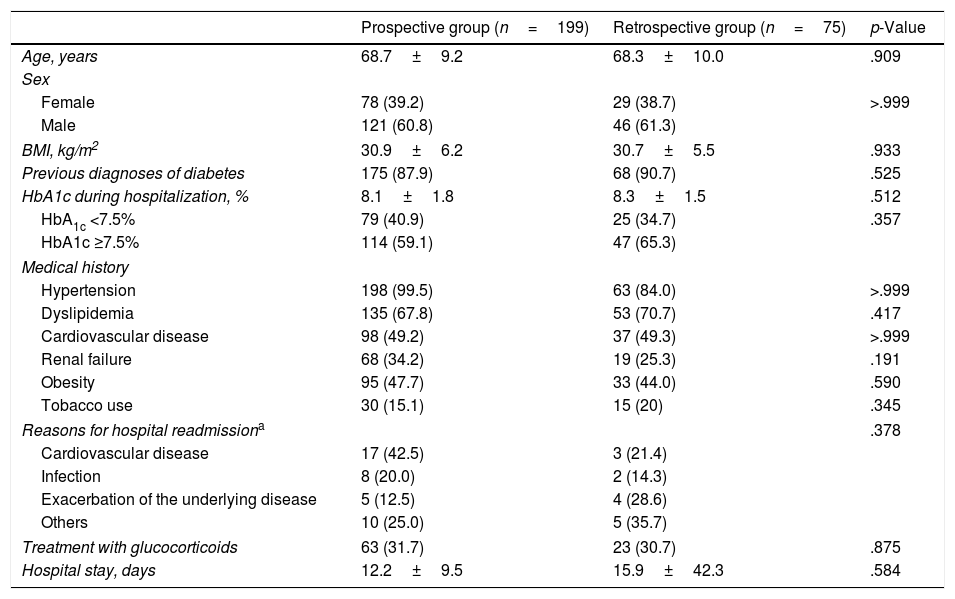Information for the adequate management of diabetic patients at hospital discharge is limited. We aimed to evaluate the impact of implementation of recommendations of the Spanish consensus for the management hospital discharge in patients with type 2 diabetes or hyperglycaemia during hospitalization.
MethodsObservational multicentric study with a prospective and a retrospective colection of patients with type 2 diabetes/hyperglycaemia (>140mg/dl) during hospitalization from 19 Spanish hospitals. Quality indicators in discharge report, antidiabetic therapy, HbA1c and adverse events were gathered at hospital admission, hospital discharge and 3 month post-discharge.
Results199 and 75 subjects in the prospective and retrospective group respectively were included. The indicators of quality in the hospital discharge reports was higher in the prospective group (p<.001). The proportion of patients with insulin, oral antidiabetic drugs (OADs), and insulin+OADs was modified at discharge in patients with HbA1c<7.5% (p<.005) and ≥7.5% (p<.001) in the prospective group and in patients with HbA 1c ≥7.5% (p<.001) in the retrospective group. At 3 month post-discharge HbA1c levels decreased from 8.2±1.9% to 7.3±1.2% (p<.001) in the prospective group, and from 8.3±1.5% to 7.2±1.2% (p<.001) in the retrospective group. Hypoglycaemic and hyperglycaemic episodes and hospital readmissions were similar in both groups.
ConclusionsImplementation of Spanish consensus recommendations for the management of hospital discharge in patients with diabetes type 2 or hyperglycaemia considerably improved the registration of quality indicators in the discharge report. Reconciliation of antidiabetic medication at the time of hospital discharge, improves glycaemic control after hospital discharge.
La información sobre el manejo de los pacientes diabéticos en el momento del alta hospitalaria es reducida. El objetivo del estudio fue evaluar el impacto de la implementación de las recomendaciones del Consenso español para el manejo del alta hospitalaria en pacientes con diabetes tipo 2 (DM2) o hiperglucemia durante la hospitalización.
MétodosEstudio observacional con un grupo de recogida prospectiva y otra retrospectiva de pacientes con DM2/hiperglucemia (> 140mg/dl) durante la hospitalización de 19 hospitales españoles. Se recopilaron indicadores de calidad en el informe de alta, terapia hipoglucémica, HbA1c y eventos adversos al ingreso, en el momento del alta y a los 3 meses del alta.
ResultadosSe incluyó a 199 pacientes en el grupo prospectivo y 75 en el retrospectivo. Los indicadores de calidad del informe de alta hospitalaria fueron mayores en el grupo prospectivo (p<0,001). La proporción de pacientes con tratamiento de insulina, fármacos antidiabéticos orales (ADO) e insulina+ADO sufrió modificaciones en el momento del alta hospitalaria de los pacientes del grupo prospectivo con HbA1c<7,5% (p<0,005) y ≥ 7,5% (p<0,001), y en los pacientes del grupo retrospectivo con HbA1c ≥ 7,5% (p<0,001). En el mes 3 tras el alta, los niveles de HbA1c descendieron de 8,2± 1,9% a 7,3±1,2% (p<0,001) en el grupo prospectivo y desde 8,2±1,9% a 7,3±1,2% (p<0,001) en el retrospectivo. Los episodios de hipoglucemia e hiperglucemia así como los de reingreso fueron semejantes en ambos grupos.
ConclusionesLa aplicación del documento español de consenso de las recomendaciones para el manejo del alta hospitalaria en pacientes con DM2 o hiperglucemia mejora de forma considerable el registro de indicadores de calidad en el informe de alta. La conciliación de la medicación antidiabética en el momento del alta hospitalaria mejora el control glucémico después del alta.
Article
Diríjase desde aquí a la web de la >>>FESEMI<<< e inicie sesión mediante el formulario que se encuentra en la barra superior, pulsando sobre el candado.

Una vez autentificado, en la misma web de FESEMI, en el menú superior, elija la opción deseada.

>>>FESEMI<<<










